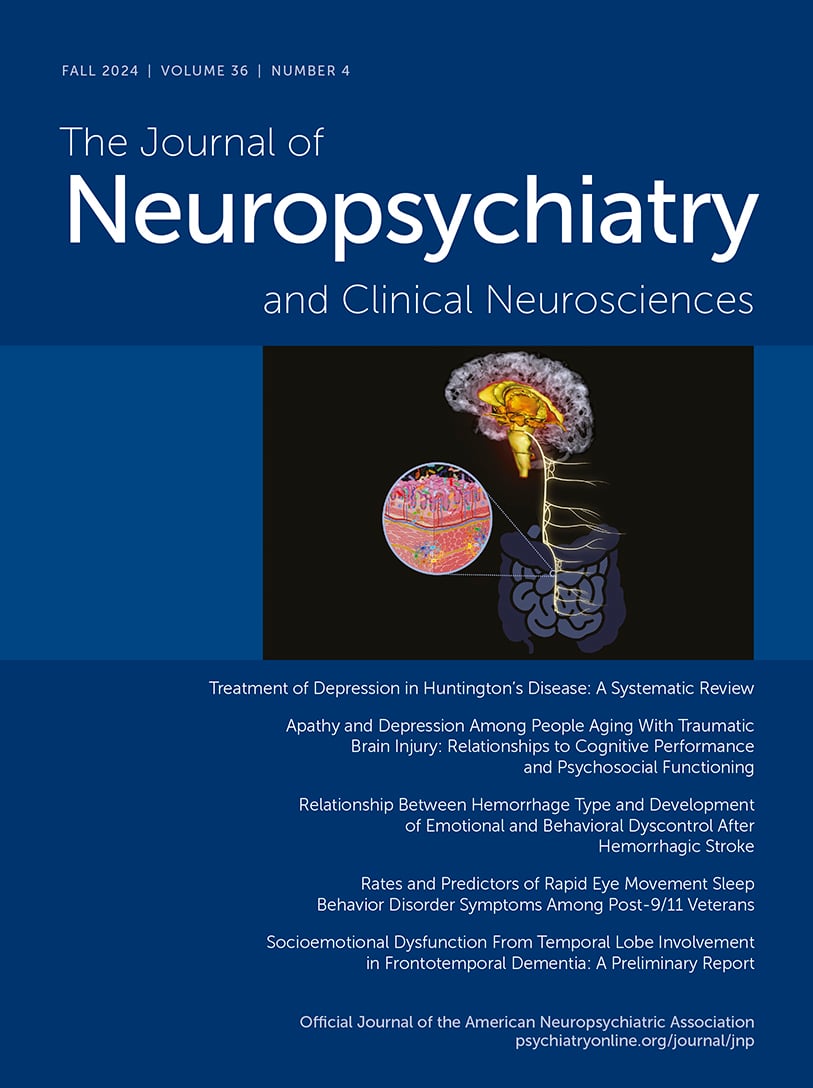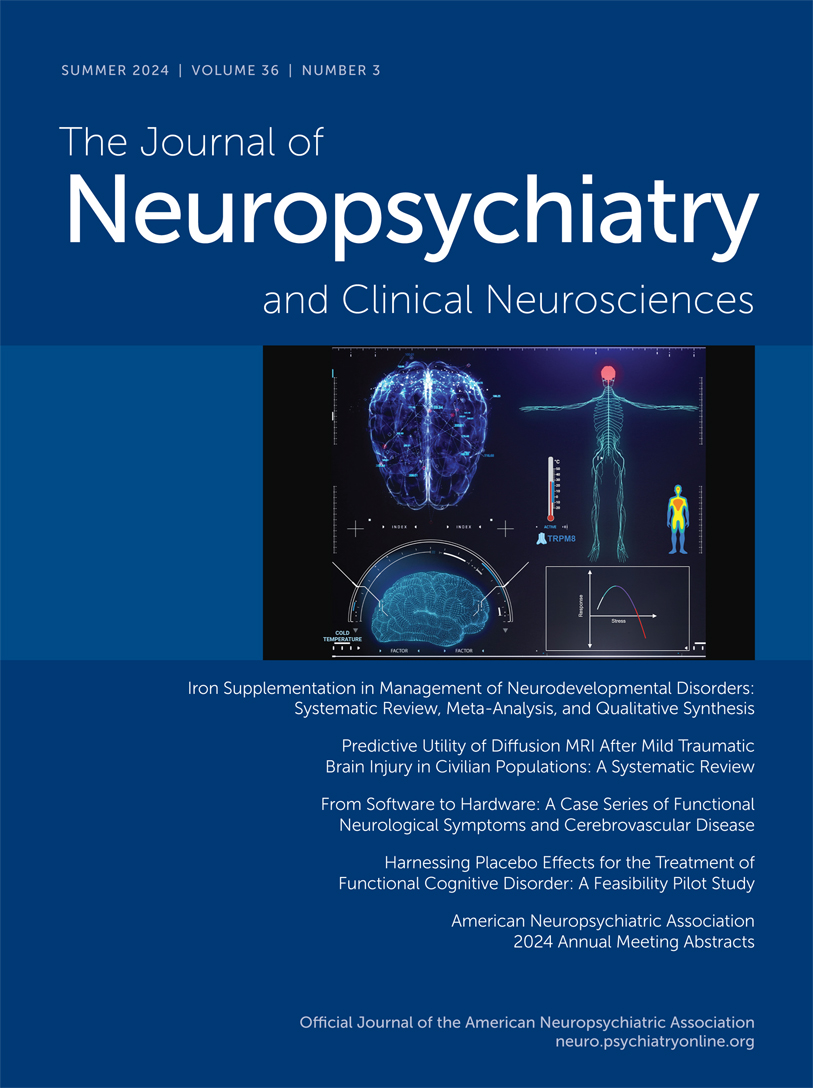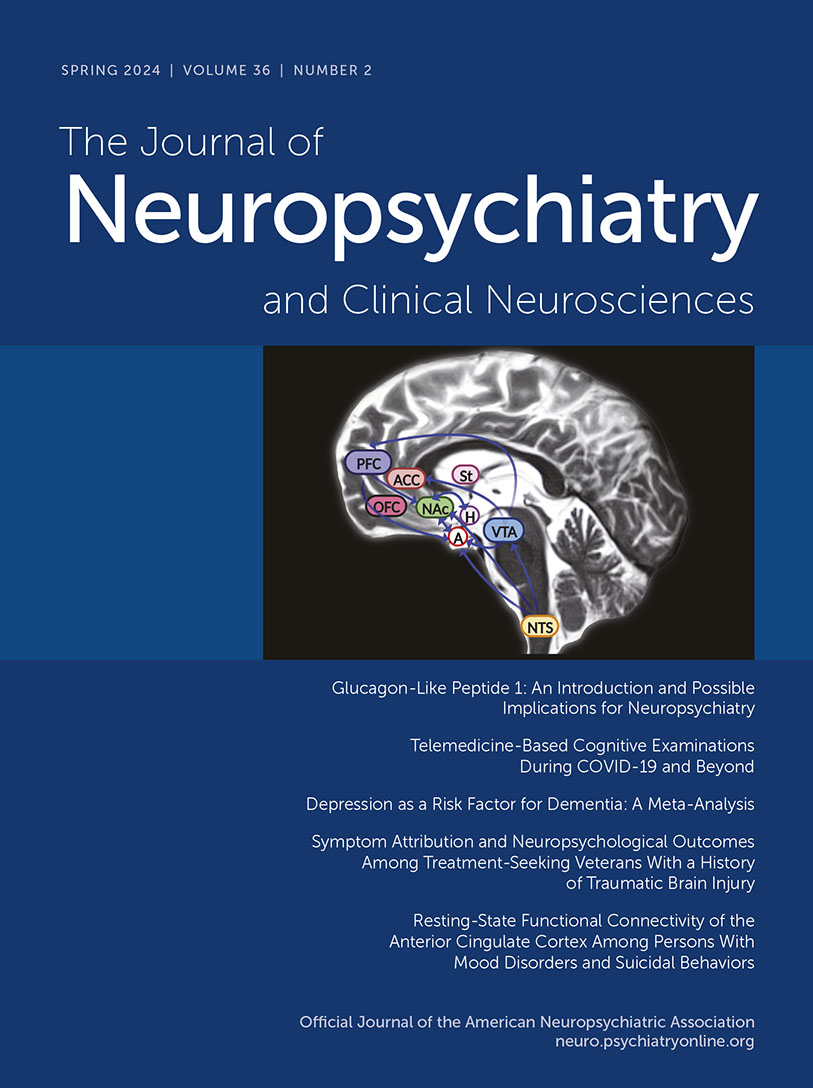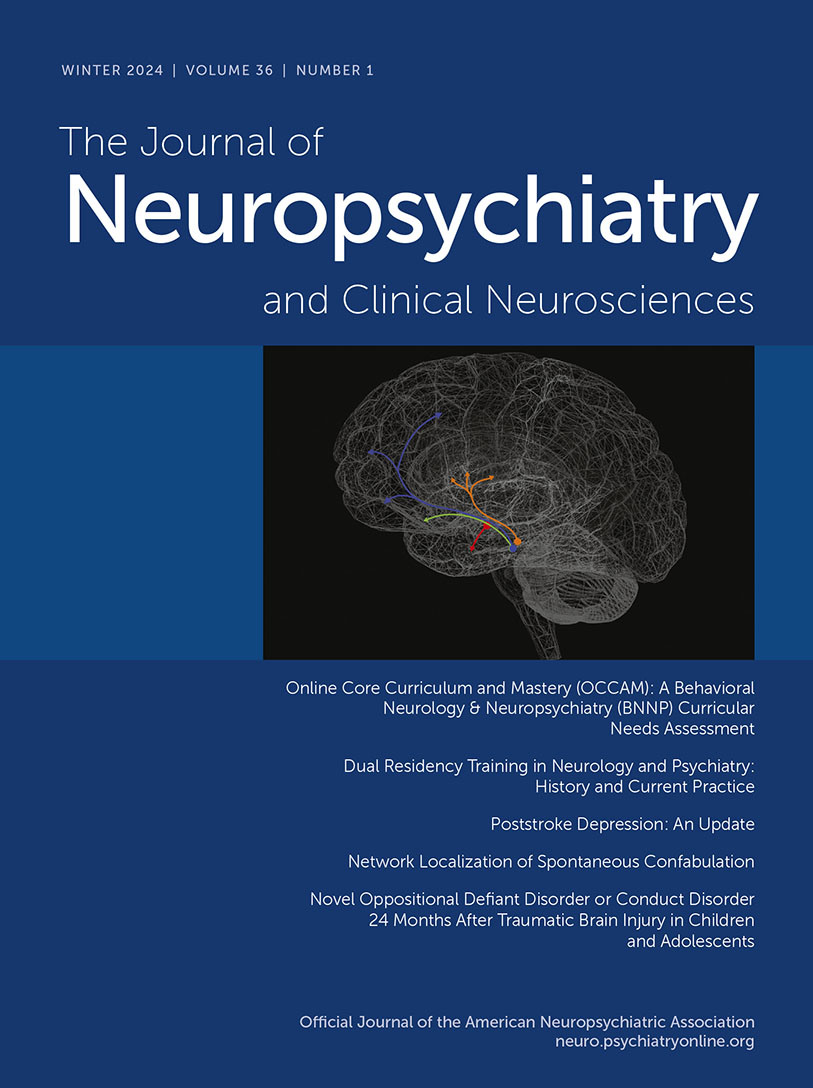The Journal of Neuropsychiatry and Clinical Neurosciences
- Volume 24
- Number 4
- October 2012
Letters
Windows to the Brain
Publication date: 01 October 2012
Pages376–383Toxoplasmosis gondii (T. gondii) an intracellular parasite discovered in 1908, is present in about one-third of the world’s population; once infected, hosts remain seropositive for life. (Known exposure risks are feline feces; raw or undercooked meat; raw ...
https://doi.org/10.1176/appi.neuropsych.12100234Special Articles
Publication date: 01 October 2012
Pages384–393Brain–behavior relationships form the foundation for clinical assessment in neuropsychiatry and behavioral neurology. The complexity of the brain and its clinical disorders makes it important to have a systematic and useful way to apply them. This article ...
https://doi.org/10.1176/appi.neuropsych.11070148Publication date: 01 October 2012
Pages394–409Although comorbid psychiatric illness is increasingly being recognized in patients with mitochondrial disorders, there has been relatively little attention to psychiatric symptomatology as the primary clinical presentation. The authors report detailed ...
https://doi.org/10.1176/appi.neuropsych.11110345Publication date: 01 October 2012
Pages410–426The authors have analyzed the religious figures Abraham, Moses, Jesus, and St. Paul from a behavioral, neurologic, and neuropsychiatric perspective to determine whether new insights can be achieved about the nature of their revelations. Analysis reveals ...
https://doi.org/10.1176/appi.neuropsych.11090214Regular Articles
Publication date: 01 October 2012
Pages427–436The authors compared a group of patients ages 7-17, who were hospitalized with either traumatic brain injury (TBI) or orthopedic injury (OI), regarding the risk of psychiatric disorder developing prospectively within the following 3 months. Patients were ...
https://doi.org/10.1176/appi.neuropsych.12060149Publication date: 01 October 2012
Pages437–443Recent findings indicate that the motor and premotor cortices are hyperexcitable in obsessive-compulsive disorder (OCD). The authors have performed the first randomized, double-blind clinical trial of repetitive transcranial magnetic stimulation (rTMS) in ...
https://doi.org/10.1176/appi.neuropsych.11100242Publication date: 01 October 2012
Pages444–451This article presents an overview of anhedonia, the inability to experience pleasure, as noted in Parkinson’s disease (PD). This symptom may be a consequence of damage to the dopamine reward systems and dopamine-related neurochemical changes. Authors ...
https://doi.org/10.1176/appi.neuropsych.11110332Publication date: 01 October 2012
Pages452–457Seizures may present with ictal or interictal psychosis mimicking primary psychiatric disorders. The authors reviewed EEG, brain-imaging, and clinical data of 240 patients presenting with acute psychotic episode to assess the diagnostic value of EEG in ...
https://doi.org/10.1176/appi.neuropsych.11120363Publication date: 01 October 2012
Pages458–462Tourette syndrome (TS) is a complex neuropsychiatric disorder affecting patients’ quality of life (QoL). The authors compared QoL measures in young patients with “pure” TS (without comorbid conditions) versus those with TS+OCD (obsessive-compulsive ...
https://doi.org/10.1176/appi.neuropsych.11080181Publication date: 01 October 2012
Pages463–471Apathy is one of the primary neuropsychiatric signatures in Parkinson’s disease, yet little research has addressed the construct validity of two commonly used apathy measures, the Apathy Scale and the Lille Apathy Rating Scale. The authors tested the ...
https://doi.org/10.1176/appi.neuropsych.11080195Publication date: 01 October 2012
Pages472–477Recognition of delirium in intensive care unit (ICU) patients is poor, despite the use of screening tools. Electroencephalography (EEG) with a limited number of electrodes and automatic processing may be a more sensitive approach for delirium monitoring. ...
https://doi.org/10.1176/appi.neuropsych.11110347Publication date: 01 October 2012
Pages478–483Parkinson’s disease (PD) decreases the quality of life (QoL) of both caregivers and patients by increasing stress and burden, and it has a negative impact on their psychological state. In the present study, the authors examined the impact of PD-patient ...
https://doi.org/10.1176/appi.neuropsych.11100315Clinical and Research Reports
Publication date: 01 October 2012
Pages484–488Neuropsychiatric symptoms (NPS) occur frequently in mild cognitive impairment (MCI) and Alzheimer’s dementia (AD). The authors examined the relationship between NPS and white-matter integrity in these conditions. Twenty-two individuals with MCI and 23 ...
https://doi.org/10.1176/appi.neuropsych.11120375Publication date: 01 October 2012
Pages489–492Huntington’s disease-like 2 (HDL2) is a rare neuropsychiatric disorder that resembles HD but results from a distinct mutation. The authors present a patient with HDL2, hospitalized for psychiatric management, and they review the neuropsychiatric ...
https://doi.org/10.1176/appi.neuropsych.11120358Publication date: 01 October 2012
Pages493–498To emphasize the importance of clinical and ultrastructural findings for diagnosing adult neuronal ceroid lipofuscinosis (ANCL), the authors retrospectively reviewed six patients with biopsy-proven ANCL. In all cases, ophthalmologic examinations were ...
https://doi.org/10.1176/appi.neuropsych.11080182Errata
Appreciation to Reviewers
Publication date: 01 October 2012
Pages501–502https://doi.org/10.1176/appi.neuropsych.244appreciationPast Issues
View Issues Archive
Vol. 36 | No. 4

Vol. 36 | No. 3

Vol. 36 | No. 2
